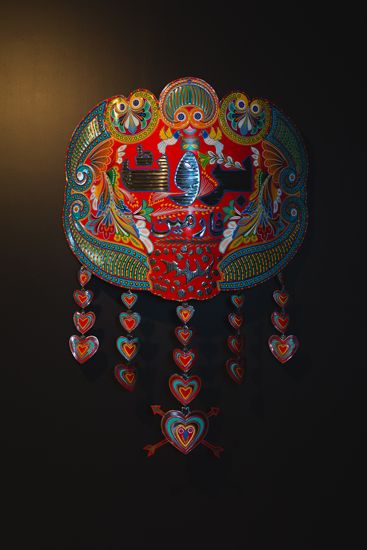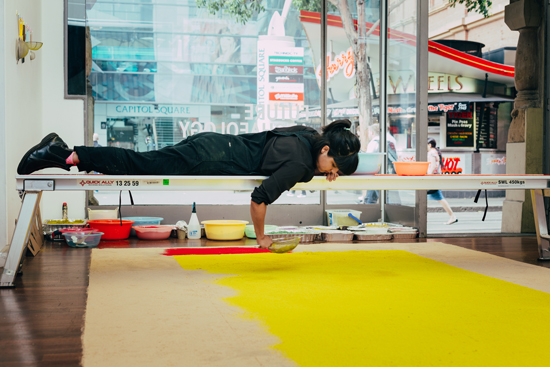Luise Guest gets out the pith helmet and spade to sort through Future Archaeology at 4A Centre for Contemporary Asian Art…
In the popular imagination, the archetypal archaeologist is Indiana Jones in a pit full of snakes, discovering the Ark of the Covenant. The reality is probably a little more mundane, but it is through an archaeological investigation of the artefacts of material culture, from stone tools to architecture, that human histories are uncovered and recorded. What then, are we to make of Future Archaeology, at the 4A Centre for Contemporary Asian Art?
Abdullah M.I. Syed, Brut for Men: Heart (Urdu version) (2013), hand-beaten metal medallion and chamak patti (hand-made sticker ornamentation), wood, stainless steel, installation view, 4A Centre for Contemporary Asian Art. Image courtesy the artist and Document Photography.
Entering the gallery space in Sydney’s Chinatown you will find an artist making a ‘carpet’ of pigmented sawdust; a series of vividly coloured sculpted metal forms like those found decorating trucks in Pakistan; works on paper referencing Iranian carpet designs and Samoan bark cloth, and a book that deconstructs western art historical images of the orientalist ‘other’. As 4A director Mikala Tai explains, these are artists who ‘interrogate concerns of the contemporary experience through an engagement and disruption of traditional practices.’ The artists role play in the guise of the archaeologist, producing new cultural ‘artefacts’ that provoke and disturb, making us question aspects of the contemporary world.
On the ground floor Claudia Nicholson is producing a newly commissioned performative work, completed in stages throughout the weeks of the exhibition and concluding at its close. Lying on a painter’s platform in full view of passers-by in the street outside, she carefully sifts coloured pigmented sawdust in patterns onto the floor. In Central and South America these ‘sawdust carpets’ are often made for Corpus Christi celebrations, laid down on the roads over which the religious procession of pilgrimage will pass. Nicholson intends to incorporate the internationally recognised symbols of global corporations such as Nike, juxtaposing them with Christian and indigenous folklore iconography. She comments on the destruction of cultural identity, lost to the unstoppable juggernaut of globalisation. It’s not a new idea – indeed, Shanghai artist Chen Hangfeng has used the traditional technique of folk-art papercuts to underscore very similar concerns. Other artists across Asia, such as Bùi Công Khánh in Vietnam, have used traditional forms of cultural heritage to interrogate contemporary realities. However, the physical form of Nicholson’s work as it takes shape across the floor is striking, with the pigmented sawdust appearing like a soft woven textile.
Claudia Nicholson, On Our Terms (2015), sawdust, dye, glitter, installation view. Image courtesy the artist and Document Photography
Deana Hitti’s lusciously seductive artist’s book represents the (white) male gaze applied to the oriental odalisques so often depicted in western art. Assimilated Museum presents black and white screen prints of images such as Ingres’ ‘La Grande Odalisque’ and ‘Turkish Bath’, with gold versions on the facing pages. Arabic text inscribed across each page provides a jolt. We are so used to seeing these images used to contrast 19th century academic painting with the early modernism of Manet that the actual women in these paintings have become invisible: they may not be veiled, but they are certainly ‘the other’.
The strongest work in this show is Abdullah M.I. Syed’s wonderful Brut for Men (2013), a series of tin sculptures based on the medallions that traditionally adorn cars and trucks in Pakistan. The work suggests complex rituals of masculinity, cultural identity and notions of adornment. The title of the series alludes to the male cologne, once endorsed by athletes, including Mohammed Ali, launched by Fabergé (now, incidentally, owned by Unilever) in 1964. The bottle featured a silver medallion, and the product was promoted with the slogan ‘Essence of Man’. Syed was interested in the divergent possibilities of the product name, its implied notion of masculinity characterised by brutality and sheer physical force, with a hint of narcissism and a pinch of vanity. His interest in ‘Art Brut’ and outsider art led to an investigation of traditional Pakistani craft practices. The riotously exuberant colour and complex designs of his medallions make them visually arresting, but it is the witty reinvention of appropriated vernacular forms, his evident respect for artisanal craft skills and the grounding of his work in an investigation of performative identity and cross-cultural dialogue that make it so interesting. Syed has said he is interested in an ‘intrinsically balanced vernacular’ and in exploring Pakistani identity in a time when it is so often presented purely as a potential source of danger.
The ‘archaeologists of the future’ in this show provide evidence, if we needed any, that it is through the work of artists – and not through the words of politicians – that the most difficult and challenging aspects of culture can be most effectively communicated.
Future Archaeology includes works by Nathan Beard, Leuli Eshra Eshraghi, Deanna Hitti, Andy Mullens, Claudia Nicholson and Abdullah M.I. Syed, until December 12 at 4A Centre for Contemporary Asian Art


